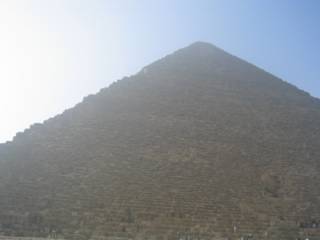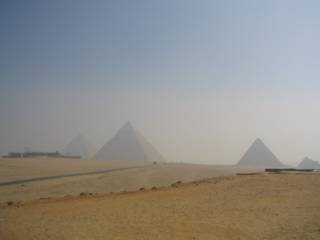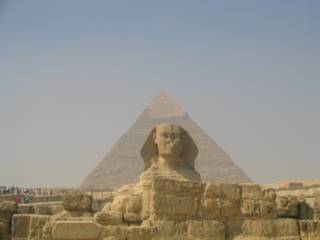We had some misunderstanding with the Sheraton hotel staff. Breakfast was included but they did not allow us into the restaurant because we are not from the Hong Kong tour. Some how, some where, we were registered as Hong Kong group (NO WONDER our rooms were nicer than the our first night). Blessings in disguise? Definitely! Anyway, once we started quoting our room number, all is cleared and we finally get to have a good breakfast.
Learned something from HZ.. don't sit near corners. The waiters always want you to sit near corners so they don't have to serve you.
After breakfast, to my horror, I realized that I have forgotten to bring the battery to my camera. It's still charging upstairs. Of all day to forget a camera! Flew all the way up 18th floor to get the battery. Phew.
1. The Pyramids of Giza
- Told us about how pyramids were made. Contrary to popular beliefs, workers were not slaves. They were compensated and put in a camp with their families. In fact, the camp even have medical facilities eg they found proof that one worker had his arm (or finger?) crushed and operations were performed to attach it back.
Made using smooth limestone rock (average weight of each rock is around 2.5 tonnes!) piled on top of each other. Take out the air by creating a vaccumn using egg white. The tomb was made of granite from where? (Aswan). There were many layers of ceiling above the tomb to create cushion. The mummy is the priority! Everything else does not matter. Zero pressure.
Started as a Bench -> Stepped Pyramid (Zojer is the King, architech is Imotep (spell?)) -> Bent Pyramid. Learned from Bent Pyramid so the architect used a new angle, 51.51 degree and built the Great Pyramid of Khufu.
Talked about the Pharoah's granite chamber (trivia: where did the granite chamber come from?) and how there were many layers of roof to even out the pressure. The top most roof is shaped like an inverted V and using modern tools to measure the roof, there are zero pressure on it! How the Ancient Egyptians achieved such technological marvel is still a mystery.
There was also a "Queen's Chamber" (so named by books) but in actual fact, it is not for the Queen. The Pyramid is only for the Pharoah. This chamber was the original chamber for the Pharoah but was abandoned because the architect thinks that it could not withstand the weight of the pyramid.
We were told not to attempt to circle the Great Pyramid as it will take a very long time to walk a complete circle.
A. Stopped at The Great Pyramid, the Pyramid of Khufu

Mido said you can't fit the Great Pyramid into your camera. Sure enough.. even though I am standing at the bus stop, my puny camera could not take the whole Pyramid. I have got to try, right?

Surprisingly, we were welcomed by this cool breeze at around 8+am. I asked habibi how did the thieves know where the entrance is? After all, there are 4 sides to the pyramids. He stood straight and with two hands pointed North. He said the entrance has to face North. Why? I don't remember :( So the thieves already know it is North. It's just that they are lucky to drill into the existing chamber. Otherwise, they would have continued drilling and found nothing. If you bring a compass and stand here, you will see that it is not exactly North. The reason is Ancient Egyptian does not use magnetic North but follow the North star.
B. Boarded bus .. stopped at Paranomic view where we rode camels

This is taken from the paranomic area. Now, we could fit all 3 pyramids. As you can see, it is not clear because of dust or "early morning dew"

In the bus, we were told that people believe that the Pyramid has some sort of magnetic aura:
- this important lady (who? Some minister?) has leukemia and when she visited Egypt, she was told of the power of the pyramids. She spent a week there and was healed.
- meat in pyramid and meat outside. The one in pyramid was preserved
- a shaving blade. Inside the pyramid, it became as though brand new
At the paranomic view, after the camel and the photo sessions:
- where he told us about the galaxy story:
When asked if the pyramids are in a straight line, as per book, he said it is not - it's a curve and he drew on the dirt about this theory that the 3 pyramids with Nile and Mediterrenean is a formation that exist in the other galaxy. Mido said it is an attempt by people to become famous, so they have all these weird theories. When asked if it is made by spacemen educating Egyptians, he cited the Bent Pyramid as an example of a pyramid built wrong. I said maybe it is a learning curve and the Bent Pyramid is just a failed project and he mentioned abt ???
C. Boarded.. stopped at Menkaure to climb down Pyramid
Mido said that people used to say that size of the third pyramid proved that the economy during Menkaure 's reign must have been affected by all these spending by his father (Khafre) and grandfather (Khufu). That's why his pyramid is the smallest. He said that is not true because unlike the two pyramids, this one is made mostly of granite and if you remember, granite is shipped all the way from Aswan. That only show the immense wealth of Menkaure.
D. Boarded the bus again and stopped at Sphinx and the Valley Temple

We are standing at the Valley Temple. This is a nice picture of the Sphinx with Pyramid of Khafre as the backdrop. Notice how this pyramid still retains its original smooth marble surface (at the tip of the Pyramid)

The Sphinx is made out of one huge rock. The area of the Sphinx is actually a mountain of limestone - the source of the materials to build the pyramids. After the pyramids were built, there was still this huge rock. The Pharoah asked the people to cut it down. But then one of the architects did an amazing thing. Instead of destroying the rock, he shaped it into the face of the Pharoah (to signify?) and the body of the lion (to signify strength). The Sphinx is actually made out of one huge rock. Later attempt by the Egyptian government to restore the Sphinx has caused worse erosion. That's why you can see many lines on the body due to restoration attempt (ze used rocks and cement)
In the Valley Temple, he talked about the mummification process
5 important things to preserve to guarantee a second life:
1. body
2. heart
3. face
4. name
5. spirit - lavendar & lotus flower
They cut a 5cm (?) on the appendix to take out the blood and inner parts. As for the brains, it was taken out from the nose and then wine were poured into the head to clear out everything. A single tissue would have destroyed the mummy.
We were shown this rectangle hole that was surrounded by a low cage. Mido said that this hole, like the hole in Luxor Temple, was used to store/hide the statues of the Gods from the Romans (or was it Christians?) when they attacked Egypt. These days, tourists started to stand back and throw coins into this hole, hoping that their wishes will come true. At the end of each day, it's the guards and the cleaners who climbed down and collected all these money... and made their wishes come true... ka ka ka.. so, habibi, yalla, yalla...
From Valley Temple we walked into this place where we could take a closer look at the Sphinx, which was on our right. Here, we were told that the Sphinx's nose was destroyed by Napoleon's cannon because Napoleon wanted to bring his civilised world to Egypt. Mido said "shame of you, Frenchman, for destroying civilisation itself."
The Sphinx used to have a beard (just like Hatshepsut) but the beard has fallen off and is now in British Museum.

This paranomic view was taken from the restaurant where we had lunch. I had to stitched a few pictures to come out with this. It's an awesome view of the 3 pyramids and the Sphinx.

LUNCH!
2. Perfume factory
3. Egyptian Museum
We saw:
- the black slab for mummification
- started with 2nd floor
- King Tutankhamun collection
a. we were shown all the "coffins" (I don't rememeber what it is called) that is used to house the main sarchophagus. These boxes are put inside one another. Again, protection of the mummy is the ultimate goal so putting them inside one box after the other will provide very good protection. These coffins were made of wood but coloured with gold. There were 8 of them (including the sarchophagus). The sarchophagus and the famous King Tut's mask is inside a special room. Sarchophagus is made of pure gold.
b. we were shown 3 beds of King Tutankhamun. One bed has leopard (or was it lionness) on the handle and legs. One has hippotamus. And the third one has (??)
According to Mido (his opinion) it is not an actual bed in his real life because it is so uncomfortable. It's probably a bed for his 2nd life.
c. we were also shown King Tut's throne. The relief in the throne is interesting. There was his wife putting perfume and massaging him. The Queen did not wear slipper to show that she's not the same status (??) as King Tut, who has slippers, of course. The decoration behind the throne has, I think, a falcon spreading his wings - again as protection.
- inside King Tutankhamun's room, I saw the famous mask. It was amazing. All made of gold! Very beautiful. There's a lot of relief on the back of the mask which I was told are symbols of protection. I saw the sarchophagus too. Again, solid gold! Was there a sceptre?
- a picture showing the journey of a Goddess (?) to the 2nd life. Her heart has to be weighed on a scale against a feather but a God is the one who ultimately influence the scale.
- near the landing of the staircase - a picture/relief on something - even more test of faith as a Goddess has to go through many trials?
- Nerfetiti's uncomplete bust
- Khufu's statue - he has the biggest pyramid but the smallest statue
- Coffin of a queen made of alabaster. Put a torch on it and can see through.
- Two statues depicting a man-warrior and his wife. Mido said the wife is the most beautiful statue they ever had.. look at the eyes.. bronze, coloured gems with a bronze nail for pupil.
- Statue of Rameses II .. not standing straight but with left foot in front.. so it won't fall. The same statue is well built - if you want to be reborn, you would want to be reborn as a fit person with muscles
4. The story of Cleopatra
Someone asked about Cleopatra and this prompted Mido to tell us a story of Cleopatra. Mido said that he thinks Cleopatra is a "I don't know how to say this but she's a hooker."
5. Papyrus Institute
My favourite art in the "pa-pa-ya-rus" institute is the blue Egyptian calendar. According to Mido, this calendar is real and is in display in
6. Khan Al-Khalili Bazaar
This area used to be capital. Mido brought us here to feel the atmosphere esp during Ramadan when you can see people eating on the streets.. eating everywhere. If we were to come tomorrow (Saturday) you won't see so many people. Ramahdan and esp if it is Friday, people like to bring their family here to just feel the atmosphere (not to shop).
7. Dinner at Chinese Restaurant and back to Sheraton
We met Mido's two sons, 8 and 4 years old in the restaurant. Cute little guys!
On our way back to the hotel, I remember he mentioned something about a Jew synanogue and how there's not many Jewish in Egypt anymore.